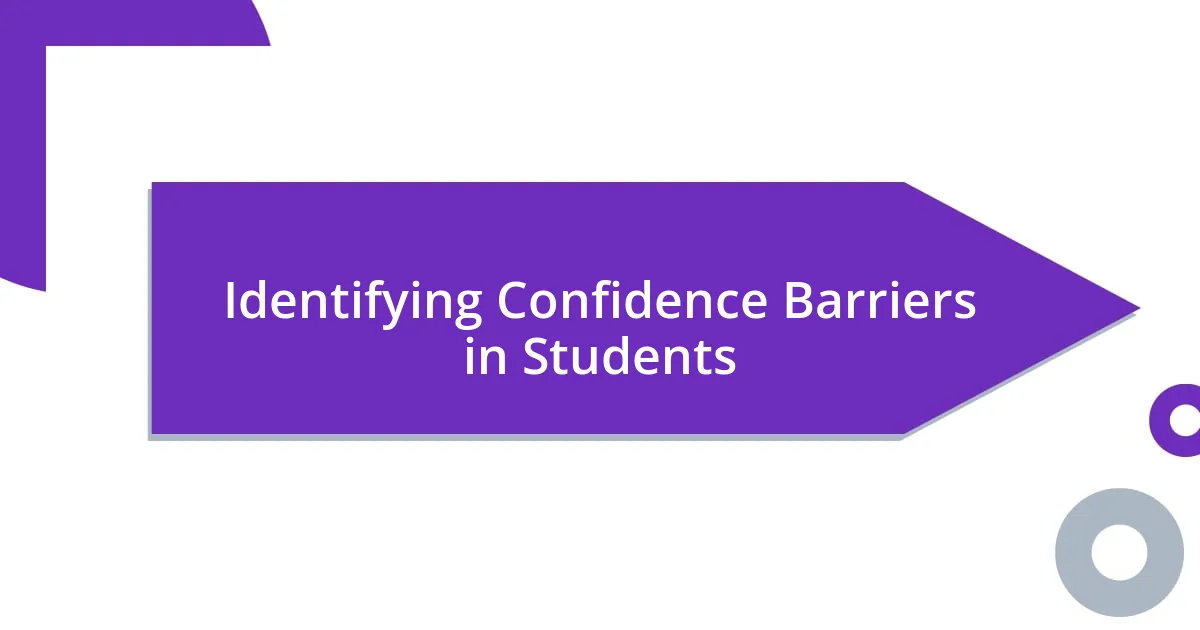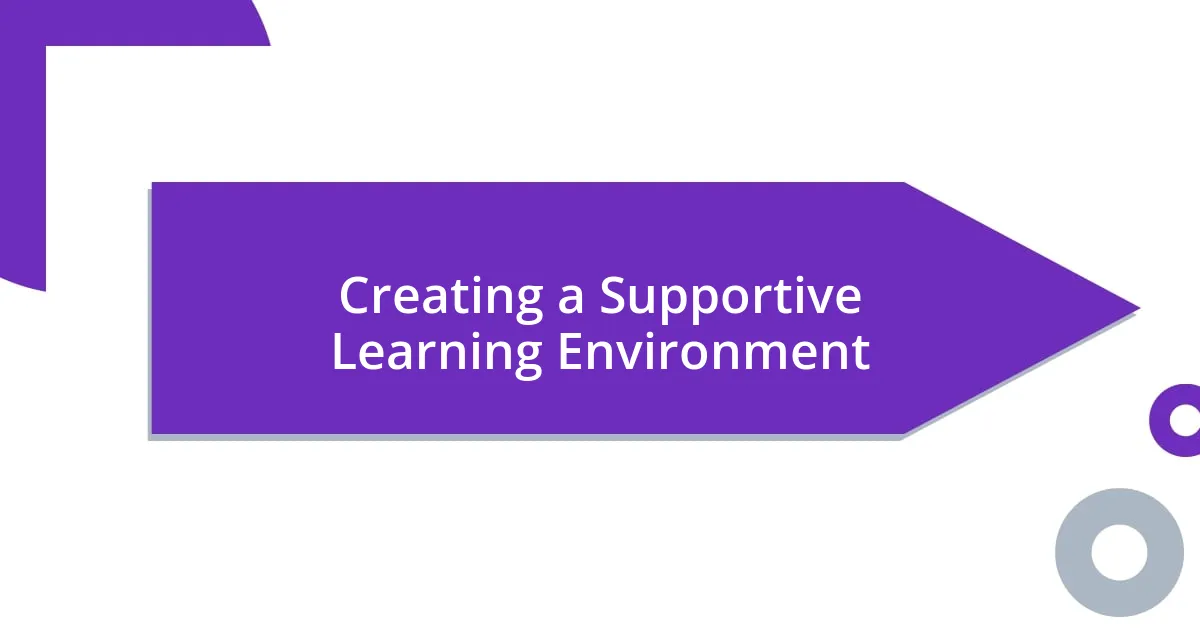Key takeaways:
- Confidence plays a crucial role in student engagement and learning, allowing students to express themselves and embrace challenges.
- Identifying and addressing barriers to confidence, such as fear of failure and negative past experiences, is essential for fostering a supportive environment.
- Implementing positive reinforcement strategies, like verbal praise and peer recognition, effectively encourages student motivation and self-assurance.
- Creating a supportive learning environment involves building trust, facilitating open communication, and celebrating achievements to bolster student confidence.

Understanding the Importance of Confidence
Confidence is a powerful catalyst for learning and growth. From my experience, I’ve seen students transform when they believe in their abilities. A shy student once shared with me how a simple compliment boosted their confidence, leading them to participate more in class. Isn’t it fascinating how just a few encouraging words can unlock potential?
When we understand that confidence impacts performance, we realize its importance goes beyond academic achievements. I recall a time when a student doubted their approach to a project. By guiding them to see their unique perspective as a strength, they not only completed the task but also found joy in expressing themselves. How often do we underestimate the fear of failure in our students?
Confidence isn’t just about feeling good; it creates a safe space for trying new things. I remember a particular workshop where students presented their projects. The palpable nervous energy turned to excitement as they gained affirmation from peers. Can you think of a moment when you stepped out of your comfort zone? That’s the confidence we strive to cultivate.

Identifying Confidence Barriers in Students
Identifying the barriers that hold students back is crucial for fostering their confidence. In my teaching journey, I’ve noticed that students often grapple with self-doubt, fear of judgement, and past experiences, which can hinder their willingness to engage. Just last semester, I worked with a student who hesitated to share their thoughts during class discussions. After some one-on-one chats, we uncovered that their reluctance stemmed from a previous experience where their ideas were dismissed. Acknowledging this, I carefully built a supportive environment that encouraged vulnerability.
Here are some common confidence barriers I’ve identified in students:
- Fear of Failure: Students often worry about making mistakes, which can paralyze them.
- Negative Past Experiences: Previous criticisms can create a lasting impact on a student’s willingness to participate.
- Comparing Themselves to Others: This can lead to feelings of inadequacy.
- Lack of Support: Without a strong support system, students may feel isolated in their struggles.
- High Expectations: Sometimes, students impose unrealistic standards on themselves, which can be daunting.
Recognizing these barriers allows me to address them directly, creating tailored strategies that promote confidence and growth.

Implementing Positive Reinforcement Strategies
Implementing positive reinforcement strategies has been a game changer in my classroom. I’ve found that simply acknowledging achievements, no matter how small, encourages students to continue striving for success. For instance, I remember rewarding a student with stickers for completing a challenging reading assignment. The joy on their face was unmistakable, and it fostered a sense of accomplishment that prompted them to tackle even tougher texts. Isn’t it amazing how something as simple as a sticker can spark motivation?
In my experience, consistent feedback is another essential component of positive reinforcement. When students receive praise for their efforts, it cultivates a growth mindset. I once had a student who struggled with math. By recognizing their persistence during a particularly hard lesson, I saw them start to believe in their capabilities. The following week, they eagerly volunteered to solve problems on the board! This transformation reinforced my belief that positive reinforcement develops engagement and self-assurance.
It’s also important to note the impact of peer recognition. I often facilitate group activities where students can celebrate each other’s accomplishments. For example, I had a student who was shy about her art skills. When her peers praised her creativity during a shared showcase, it lit up her confidence like a light bulb. How can we create more moments like this? By designing opportunities for students to uplift one another, we create a supportive community that thrives on encouragement.
| Positive Reinforcement Strategies | Examples |
|---|---|
| Verbal Praise | Complimenting a student’s effort or creativity during projects or class discussions. |
| Reward Systems | Using stickers or small prizes to celebrate achievements, which I’ve seen boost motivation immensely. |
| Peer Recognition | Facilitating group activities that encourage students to applaud each other’s successes, reinforcing community and confidence. |

Creating a Supportive Learning Environment
Fostering a supportive learning environment means cultivating a space where students feel safe to express themselves. I remember a time when I rearranged my classroom to create cozy discussion corners. This small change had a profound effect—students began to share their thoughts more freely, and I could see them blossom. Isn’t it incredible how the physical setup can encourage or hinder open communication?
In my experience, establishing trust is key to building a supportive atmosphere. I often start each class with a brief check-in, asking students how they’re feeling or what challenges they’re facing. Even just sharing light-hearted anecdotes can break the ice. Once, a student opened up about their nerves before a big presentation, and the entire class rallied to offer their support. It turned into a moment of collective encouragement that strengthened our class bond, proving that vulnerability can be a powerful connector.
Additionally, I emphasize the importance of every voice in my classroom. I make it a point to call on quieter students and encourage them to share their thoughts during discussions. One day, I noticed a usually quiet student brighten up when I recognized their unique perspective on a topic. Watching their confidence grow was a testament to the environment we had crafted together. It really makes me wonder, how much potential might go untapped if we don’t create spaces that celebrate every individual?

Encouraging Risk-Taking in Learning
Encouraging risk-taking in learning is often about reframing failure as a stepping stone rather than a setback. I recall an instance when I invited my students to tackle an experimental project with no strict guidelines. Initially, you could feel the tension in the room. But when one brave student chose to go in an unexpected direction, it ignited a wave of creativity. Watching them embrace uncertainty made me realize how vital it is to create an environment where trying new things becomes part of the learning narrative. Isn’t that what learning should feel like—an adventure?
Another significant moment for me was during a science fair project where I encouraged students to pursue their passions, even if their ideas seemed a bit unconventional. A student who loved video games decided to explore the environmental impact of e-waste. When he presented his findings, the pride he expressed was palpable. It struck me then that, by supporting them to explore their interests, I was helping them build confidence through risk-taking. Who knew that stepping outside the comfort zone could yield such incredible results?
I’ve observed that cultivating a culture where questions are celebrated can also spur risk-taking. In one class, I implemented a “Question Wall,” allowing students to anonymously post anything they were curious about. To my surprise, the variety of questions was remarkable! This not only prompted spirited discussions but also helped students feel validated in their inquisitiveness. It made me wonder, isn’t curiosity itself a form of risk-taking? When students aren’t afraid to ask, they open themselves up to new possibilities and learning experiences that can greatly enhance their confidence.

Providing Constructive Feedback and Guidance
I believe that providing constructive feedback is crucial for nurturing confidence in students. I’ve found that phrasing feedback positively encourages students to see their strengths alongside areas for improvement. For example, after one student submitted a poem, I made sure to highlight their unique imagery before suggesting a few edits. The smile on their face—priceless. It reminded me of how uplifting it can be to start with a compliment; it transforms what could be a moment of disappointment into one of motivation.
In my experience, giving specific guidance during the revision process is another effective strategy. There was a time when a student was struggling with their writing assignment, feeling overwhelmed by the feedback they received. I sat down with them and went through their draft line by line. By breaking it down into manageable steps, I watched their anxiety fade away, replaced by clarity and determination. It’s moments like these that make me think: how can we expect students to gain confidence if we don’t give them the tools to understand their own growth?
I also find it essential to follow up on the feedback I provide. I remember checking in with a student weeks later, asking about their revisions on a project they initially found daunting. To my delight, they expressed how my suggestions inspired them to take ownership of their work. It was rewarding to witness their journey, and it prompted a realization: encouraging confidence is an ongoing dialogue, not just a one-time conversation. Isn’t it remarkable how a little ongoing support can lead to newfound resilience?

Celebrating Achievements and Progress
Celebrating achievements, no matter how small, can be a powerful booster for confidence. I remember a particular project where students had to write and perform their own skits. After their presentations, I initiated a “Bravo Board,” where classmates could post notes praising each other’s efforts. The look on their faces when they read heartfelt comments was incredible—it felt like a moment of pure validation. It made me realize that recognition can light a spark within students, encouraging them to strut their stuff with pride.
I’ve also found that incorporating regular check-ins about personal progress is essential. During one term, I adopted a casual “progress party” where students could share their accomplishments. One student, who had always struggled with math, shared how he’d improved his test scores significantly. The cheers that erupted in the room were genuine and infectious! That day, it struck me just how vital it is to foster a culture where achievements are celebrated; it builds a sense of community and reassurance that we’re all in this together.
Another approach I’ve loved is tracking progress visually. In my classroom, I set up a “Growth Chart” for each subject, where students can add stickers representing milestones they’ve reached. Watching one shy student proudly add a sticker after mastering a tough concept was memorable. It reminded me that tangible representations of progress not only make achievements concrete but also fuel that internal motivation—don’t you think seeing one’s journey mapped out can boost a sense of ownership in their learning?














